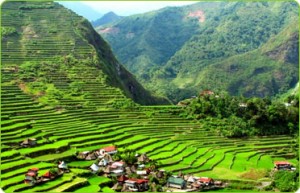Locals to this day still plant rice and vegetables on the terraces, although more and more younger Ifugaos do not find farming appealing, often opting for the more lucrative hospitality industry generated by the Rice Terraces. The result is the gradual erosion of the characteristic “steps”, which need constant reconstruction and care. In 2010 a further problem was drought, with the terraces drying up completely in March of that year.
Tourism
Another thriving economy in the Banaue Rice Terraces is tourism. The Tourism industry has developed a number of activities for visitors which may include the traditional sight seeing of the terraces and visits to the tribes at the foot of the terraces. A Mumbaki (traditional Ifugao witch doctor) is also recommended to visitors, these doctors can perform spiritual healing rituals. Domestic tourism however has gone down over the past few years. A contributing factor to this is the treatment of domestic tourists by the local guides in the area where it has been reported that local guides are more willing to entertain foreign visitors. The Batad Environmental Tour Guides Association (BETGA) in association with the Batad Baranguay authorities are currently laying a concrete track down from the Batad Saddle to the village proper.


